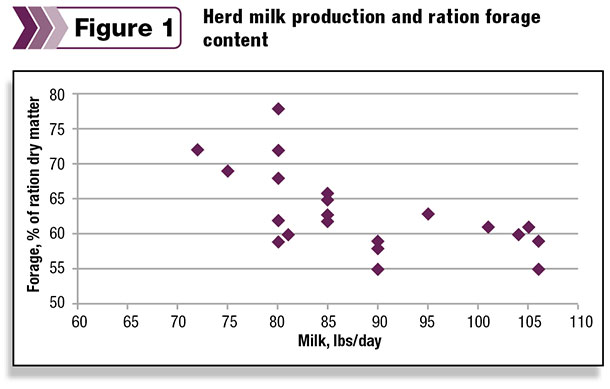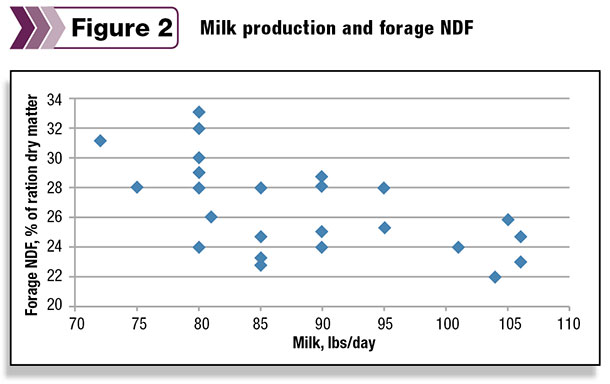Dairy cattle and other ruminants are biologically designed to convert forages and other fibrous feeds into high-quality products such as milk and meat for human consumption. Forages also provide the foundation upon which nutritionally sound, rumen-healthy and profitable dairy rations are built. The trend in the Northeast has been to increase the proportion of the total ration from forage in the last 10 to 15 years.
One reason is that feeding higher levels of forage lowers the amount of purchased concentrate used. This provides an opportunity to increase income over purchased feed cost.
A second reason is that there have been continuous improvements in the fiber digestibility of the corn silage hybrids and forage varieties sold by the seed companies.
There is also a better understanding of the importance of laboratory forage neutral-detergent fiber (NDF) digestibility values and how to incorporate these into rations.
What is a high-forage ration? There are a number of ways that this can be expressed. The three most common are:
• Forage comprising more than 60 percent of the total ration dry matter
• Forage NDF intake is greater than 0.9 percent of bodyweight
• Forage NDF is more than 25 percent of the total ration dry matter
How much forage are some herds feeding? We have put together data from about 35 herds feeding higher-forage rations. All of these herds are producing greater than 75 to 80 pounds of milk per cow per day and have rations that contain more than 60 percent of the total ration dry matter as forage.

Figure 1 contains the milk production and the percentage of the ration comprised of forage in these herds. The relationship between forage NDF on the ration and milk production is in Figure 2 . In both figures, these herds’ proportions of the ration from forage and forage NDF are higher than have previously been fed in dairy herds.

How do these herds attain these higher levels of forage in the ration and produce these levels of milk? One key is to have a consistent supply of high-quality highly digestible forage available. These have a higher rate of digestion and rate of passage in the rumen.
This provides more nutrients to support rumen fermentation and makes more space available in the rumen to allow higher levels of feed intake. Previous guidelines were that total NDF intake would be about 1.2 percent of the cow’s bodyweight and that a minimum of 75 percent (0.9 percent of bodyweight) of this should be from forage.
Recent reviews of research reports for both cows on pasture and consuming TMRs indicate forage-NDF intakes of 1.3 to 1.6 percent of bodyweight. This provides an opportunity to feed higher levels of forage in the ration as indicated in Figures 1 and 2.
There are a couple new terms that are starting to be used in describing the NDF portion of the forage. These are in addition to NDF digestibility currently provided by most forage testing labs. One is indigestible NDF.
This is the portion of the NDF that will not be digested. Previously, it was estimated by multiplying the forage lignin content by 2.4. Now labs are doing a long-term (240 hours) in vitro fermentation to directly determine this value.
The second change will be to divide the digestible NDF portion into fast and slow pools. This will provide two rate-of-digestion values for forage rather than the one value currently reported. These values will help to better describe forage NDF in computer models and help in using higher levels of forage in dairy rations.
At the 2010 Cornell Nutrition Conference, Emiliano Raffrenato and Mike Van Amburgh provided some initial data on this approach by comparing conventional and BMR corn silage. Indigestible NDF was 20.6 percent of total NDF in conventional corn silage but only 13.1 percent in the BMR corn silage.
Total NDF in the fast-digestion pool was 73.7 percent for BMR and 60.7 percent for conventional corn silage. This example may help explain why cows can utilize higher levels of higher-quality forages. Forage labs will eventually be able to provide these values to help develop rations.
What are the risks and challenges of feeding higher-forage rations in dairy herds? The most common ones that need to be considered are:
1. Mindset – Both the dairy producer and the herd nutritionist need to believe that this concept is valid and that you can produce milk using high-quality forages. If this isn’t true, higher-forage rations won’t be successful.
2. Consistent-quality forages – Can you produce, harvest, store and utilize high-quality forages? Since forages are a larger portion of the total ration, the impact of variations in forage quality on dry matter intake and milk production will be magnified. There will be less opportunity to adjust for changes in forage quality in the grain mix since less grain is being fed.
3. Forage inventory – It may take 15 to 40 percent more forage to feed the same number of cows when higher-forage rations are fed. Do you have this inventory available? Can you alter crop management to produce more forage from your land base?
Can you improve storage and feeding management to decrease losses? You may need to work with your crop adviser to look at opportunities in crop rotations and harvest management procedures. Double-cropping is one potential way to improve yields by 10 to 25 percent per acre.
4. Forage storage and allocation – Do you store forages by quality? Can you allocate the forages fed to specific animal groups based on the quality needed by the group?
5. Forage analyses – More frequent analyses are needed to keep the feeding program on target. NDF digestibility should be used as part of a routine forage analysis program.
6. Ration formulation and adjustments – The adjustments required will depend on the potential changes in forage analysis results.
7. TMR mixer management – High-forage rations are bulkier and your current mixer may not have the capacity to mix a higher-forage ration for a group of cows. Multiple mixers may be needed.
8. Feeding management – The goal is to have a consistent supply of fresh, palatable and high-quality ration available throughout the day. This may mean alterations in frequency of mixing rations or pushing up feeds.
Higher-forage rations are a management tool that should be evaluated by dairy producers. The items pointed out above should be considered as part of this process. The actual level of forage fed will be a very individualized herd decision.
Dairy producers that have implemented this approach report lower purchased feed costs, increased income over feed cost and purchased feed cost, higher milk components, lower involuntary culling and better cow health. PD
L.E. Chase is with the department of animal science at Cornell University.






